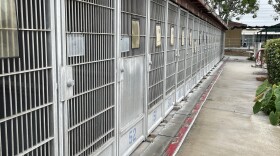A recent statewide water quality report found San Diego’s South County has two of the state’s most polluted beaches and they are both at the mouth of the Tijuana River, just north of the international border.
The Heal the Bay report said water quality testing reveals the two beaches are among the dirtiest in the state. Cross-border pollution is to blame.
Public complains, lawsuits, lobbying and cajoling from local officials finally convinced federal officials to put money into a border pollution project to work for a fix.
RELATED: Three San Diego County Beaches Ranked Among Cleanest In State
Re. Mike Levin, D-Dana Point, delivered the good news in January 2020.
“We have successfully secured $300 million under the border water infrastructure program to aggressively address the cross-border pollution from the Tijuana River Valley,” Levin said.
The news that money was tucked into the United States-Mexico-Canada trade agreement came after South County residents endured more than two years of massive and persistent cross-border flows.
It was estimated that billions of gallons of sewage tainted water entered the U.S., flowed through the Tijuana River Valley and reach the ocean.
Pollution warning signs were posted most of the summer in Imperial Beach.
But that optimistic news about federal funding happened nearly 18 months ago.
The local congressional delegation was there, a county supervisor, the mayor of San Diego and Imperial Beach officials celegrated the news.
But the event happened so long ago that three politicians, Kevin Faulconer, Susan Davis and Greg Cox, no longer hold public office. And the Environmental Protection Agency has yet to decide how to spend the $300 million.
RELATED: Tijuana River Valley Pummeled By Garbage
“In August we hope to identify the preferred project alternatives,” said Tomás Torres, the director of the water division in the Environmental Protection Agency’s region nine office.

“And once we do that they will undergo a pretty comprehensive environmental analysis,” Torres said.
San Diego County officials already invested time and money to identified 27 possible projects to control the flows which routinely overwhelm Tijuana’s sewage system.
The largest project is a new sewage treatment plant capable of treating 163 million gallons of tainted water a day.
“This would be in the U.S,” Torres said. “It would capture these flows and we’re looking at various treatment capacity options of what size that plant should be to provide the most protection at the optimum cost. As you probably know, infrastructure in the U.S. is very costly.”
That plant would likely cost more than the $300 million set aside in the EPA’s budget, which means local officials would have to find more money.
And some of that federal money could end up paying for projects in Mexico.
RELATED: Sewage Flows Continue To Foul South San Diego County Beaches
“We were analyzing projects that would make improvements to Tijuana’s wastewater conveyance system in order to reduce sewage from entering the Tijuana River in the first place,” Torres said.
That idea has roiled some San Diego clean water advocates who fear money spent south of the border is ineffective. They want projects built in the United States.
The contamination issue is nothing new to San Diego County District 1 Supervisor Nora Vargas. She’s worked to fix the problem for decades.
“Tijuana River Valley contamination is not a San Diego District 1 issue. And it’s not a Tijuana issue. There’s a global international issue that we need to address together and it’s going to take all of us coming together,” Vargas said.
Vargas convinced the San Diego County Board of Supervisors to declare the situation in the Tijuana River Valley a public health crisis. It was the first time the situation was considered to be more than an environmental issue.
“I actually feel that things are starting to move forward,” Vargas said.
But Vargas also acknowledges that the problem won’t be fixed by the end of this year or even next.
RELATED: San Diego Officials Call Tijuana River Valley Sewage Flow A Public Health Crisis
EPA officials expect to unveil their preferred alternatives next month and that will start the clock on mandated and exhaustive environmental reviews.
“Even though it is a lengthy process we’ve been able to cut that down to less than half the time it normally takes,” Torres said.
But while those environmental reviews will ensure that the projects protect the places where they will be built, the delay will not help with sewage flows this summer, or next, or even the summer after that.
Short term relief may come from federal, state and local officials who are working on some projects in canyons. Or relief could come elsewhere.
“At this point it really depends on Mexico,” said Imperial Beach Mayor Serge Dedina. “If Mexico wants to not dump sewage along the beach, we’ll have a good summer. But if they continue to do what they do, which is dump sewage everywhere in the Tijuana River as well as along the beach, you know, it could be an unhappy summer for us.”
Dedina is hopeful because the EPA is moving forward, but if the agency efforts stall, local municipalities and clean water groups could revive federal lawsuits seeking to force the government to clean up the problem.






